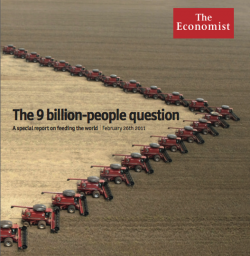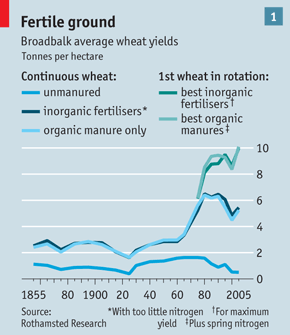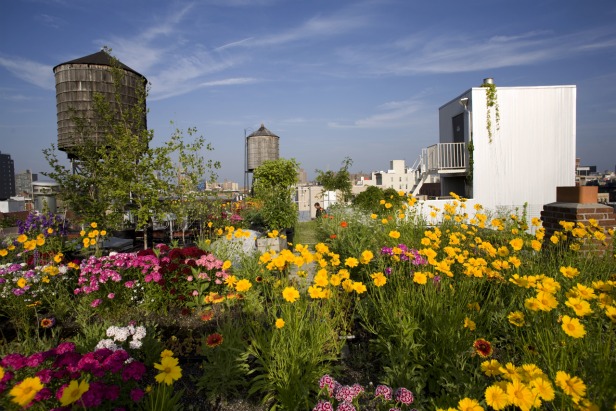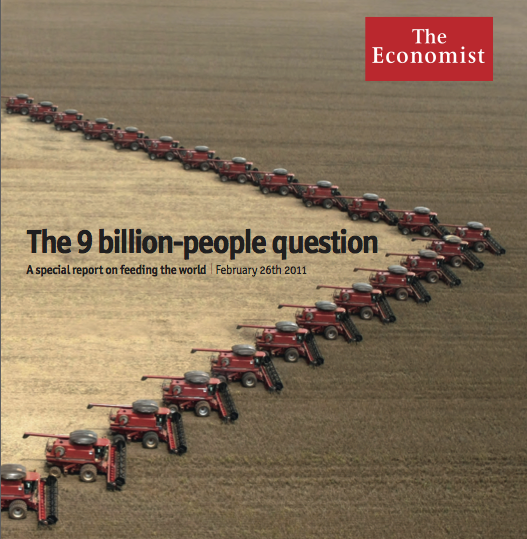 This isn’t the only way.I’ve been reading The Economist’s “Special Report on Feeding the World” (intro here). So far, it’s typical Economist: compellingly written and impressively broad in scope — but largely uncritical of the status quo. The report doesn’t bring much new to the table, especially to those of us who follow the gloomy macro-analyses of thinkers like Lester Brown.
This isn’t the only way.I’ve been reading The Economist’s “Special Report on Feeding the World” (intro here). So far, it’s typical Economist: compellingly written and impressively broad in scope — but largely uncritical of the status quo. The report doesn’t bring much new to the table, especially to those of us who follow the gloomy macro-analyses of thinkers like Lester Brown.
Predictably enough, The Economist’s perspective on the “feed the world” question is guided by the assumption, never much examined, that only high-tech, massive-scale farming can tackle the task of feeding the 9 billion people expected to be on Earth by 2050. The series’ lead editorial frames the question like this:
[While] the concerns of the critics of modern agriculture may be understandable, the reaction against intensive farming is a luxury of the rich. Traditional and organic farming could feed Europeans and Americans well. It cannot feed the world.
 From The Economist. Forget, for a minute, that this statement warms over a stale agribusiness talking point: there is no alternative to corporate-dominated agriculture. Instead, take a look at the chart, reproduced at the right, lifted from the top of this very same editorial. The chart describes average wheat yields under different forms of agricultural management at the Broadbalk field in England’s famed Rothamsted Research station. The Economist describes the Broadbalk field like this:
From The Economist. Forget, for a minute, that this statement warms over a stale agribusiness talking point: there is no alternative to corporate-dominated agriculture. Instead, take a look at the chart, reproduced at the right, lifted from the top of this very same editorial. The chart describes average wheat yields under different forms of agricultural management at the Broadbalk field in England’s famed Rothamsted Research station. The Economist describes the Broadbalk field like this:
Broadbalk is no ordinary field. The first experimental crop of winter wheat was sown there in the autumn of 1843, and for the past 166 years the field, part of the Rothamsted Research station, has been the site of the longest-running continuous agricultural experiment in the world. Now different parts of the field are sown using different practices, making Broadbalk a microcosm of the state of world farming.
You don’t have to look very closely at the chart to see that fields treated with manure produce roughly identical yields to those treated with “inorganic fertilisers,” i.e., synthetic nitrogen, mined phosphorous, etc. In other words, based on the Broadbalk experiments highlighted by The Economist itself, there’s no reason to assume, a priori, that organic farming “cannot feed the world.”
Next, dig into the Rothamsted center’s own report [PDF] on its experiments. There, you’ll find that the Broadbalk fields treated with manure not only deliver roughly equal yields, but also are better at building up both organic matter and microbial activity in the soil — both critical measures of soil health.
It’s puzzling that a special series premised on dismissing organic agriculture would lead with a chart that vindicates it. Organic agriculture probably can feed the world at least as well as the agribusiness-driven variety. It’s just that it can’t feed the minds of The Economist’s editors, who are fixated on images of gigantic machines dispersing agrichemicals onto vast fields monocropped with GMO seeds. When it comes to envisioning the future of agriculture, the magazine’s thinkers appear to suffer from what Vandana Shiva has called “monocultures of the mind.”
—–
From deep in the Grist archives, here’s my riposte from January 2007 to another Economist attack on organic ag.




